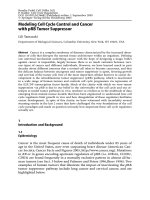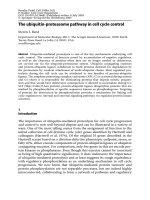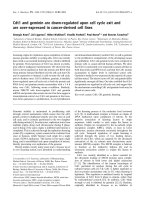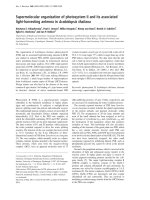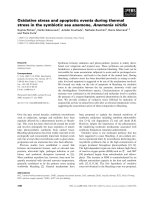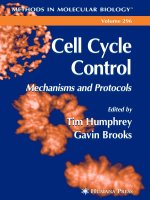Cell cycle control and fate determination during male gametogenesis in arabidopsis thaliana
Bạn đang xem bản rút gọn của tài liệu. Xem và tải ngay bản đầy đủ của tài liệu tại đây (11.74 MB, 198 trang )
CELL CYCLE CONTROL AND FATE
DETERMINATION DURING MALE
GAMETOGENESIS IN ARABIDOPSIS THALIANA
CHEN ZHONG
(B. Medical Sci. Peking University )
A THESIS SUBMITTED
FOR THE DEGREE OF DOCTOR OF PHILOSOPHY
DEPARTMENT OF BIOLOGICAL SCIENCES
NATIONAL UNIVERSITY OF SINGAPORE
2009
ACKNOWLEDGEMENTS
ACKNOWLEDGEMENTS
I would like to express my wholehearted gratitude to my supervisor, Professor Frederic
BERGER, for offering me the opportunity to pursue the Ph.D. degree in his laboratory
and introducing me to the wonderful and exciting world of plant science. I deeply
appreciate Fred for his excellent supervision, consistent encouragement, and great
support throughout the course of my research work, and also for his invaluable
amendments to my thesis.
My sincere thanks go to my graduate supervisory committee members: Dr. Toshiro ITO,
Dr. Yuehui HE and Dr. Huck Hui NG for their invaluable suggestions and great
encouragement during the course of my work.
I thank all my current lab members in Chromatin and Reproduction Group: Lijing,
Pauline, Sarah, Heike, Jeanie, Ramesh, Thiet, and Peiqi for sharing experiences and
creating a helpful working environment. My thanks to former members of the lab:
Jonathan, Mathieu, Tadashi and Sebastien. Thanks also go to my attachment students
Shihui, Meilun and Kim.
I appreciate all facilities of Temasek Life Sciences Laboratory, especially thank to
Graham and Ouyang Xuezhi from Microscopy and Imaging Facility. I thank the funding
from Temasek Life Sciences Laboratory and Singapore Millennium Foundation.
My deepest appreciation goes to my wife Shijie, my parents and parents-in-law, for their
love, encouragement and support for all these years. Finally, my affection goes to my
newborn daughter Yinuo, you bring me so much fun and awareness of responsibility.
September 2009
i
TABLE OF CONTENTS
TABLE OF CONTENTS
ACKNOWLEDGEMENTS
i
TABLE OF CONTENTS
ii
LIST OF FIGURES
vi
LIST OF TABLES
ix
LIST OF ABREVIATIONS
x
SUMMARY
xii
CHAPTER I: INTRODUCTION
1
1.1. HOW DO COMPLX MULTICELLULAR ORGANISMS DEVELOP?
2
1.1.1. Cell cycle overview
2
1.1.2. Cell differentiation overview
6
1.1.3. Coordination of cell cycle and cell differentiation
9
1.2. ARABIDOPSIS DEVELOPMENT
12
1.2.1. The life cycle of Arabidopsis
12
1.2.2. Flower: the display of sexual reproductive organ
14
1.2.3. Male gametophyte development
14
1.2.4. Female gametophyte development
15
1.2.5. Double fertilization
17
1.2.6. Seed development
17
ii
TABLE OF CONTENTS
1.3. POLLEN DEVELOPMENT
21
1.3.1. Asymmetric pollen mitosis and differential cell fate
21
1.3.2. Models of cell-fate determination
23
1.3.3. Symmetric pollen mitosis and sperm cell formation
26
1.4. AIM OF THE STUDY
29
1.4.1. S phase chaperones – Chromatin Assembly Factor 1
29
1.4.2. G1/S cell cycle repressor – RBR
33
1.4.3. Strategy of the study
38
CHAPTER II: MATERIALS AND METHODS
39
2.1. MATERIALS
40
2.1.1. Plant material
40
2.1.2. Enzymes, primers and kits
41
2.1.3. Cloning vectors and constructs
41
2.1.4. Bacterial strains
41
2.2. METHODS
42
2.2.1. Plant work
42
2.2.2. Molecular-biological methods
43
2.2.3. Microscopy and cytological methods
50
CHAPTER III: RESULTS
56
3.1 CHROMATIN ASSEBLY FACTOR 1 REGULATES THE CELL
57
CYCLE BUT NOT CELL FATE DURING MALE GAMETOGENESIS IN
ARABIDOPSIS THALIANA
3.1.1. Reduced paternal transmission of msi1 loss-of-function alleles
iii
57
TABLE OF CONTENTS
3.1.2. Reduced paternal transmission of msi1 is enhanced by further loss of
63
CAF1 function
3.1.3. Loss of MSI1 arrests pollen development
64
3.1.4. Loss of CAF1 activity causes delay and arrest of the cell cycle in pollen
68
3.1.5. Cell fate specification and differentiation is normal in CAF1 deficient
72
pollen
3.1.6. Pollination with msi1 pollen causes single-fertilization events
3.2. PROLIFERATION AND CELL FATE ESTABLISHMENT DURING
76
82
ARABIDOPSIS MALE GAMETOGENESIS DEPENDS ON THE
RETINOBLASTOMA PROTEIN
3.2.1. Reduced paternal transmission of rbr alleles
82
3.2.2. Limited cell over-proliferation in rbr pollen
85
3.2.3. Cell fate in rbr pollen
91
3.2.4. rbr pollen defects are rescued by deregulation of the cell cycle
96
CHAPTER III: DISCUSSION
98
4.1. CAF1 REGULATES CELL CYCLE BUT NOT CELL FATE DURING
99
MALE GAMETOGENESIS
4.1.1. Loss of MSI1 function affects CAF1 function during pollen
99
development
4.1.2. Loss of CAF1 function in pollen arrests cell cycle but does not alter cell
101
fate
4.2. REGULATION OF SPERM FUSION DURING DOUBLE
FERTILIZATION
iv
105
TABLE OF CONTENTS
4.2.1. Isomorphism or dimorphism of sperm cells
105
4.2.2. Preferential or random fertilization
105
4.2.3. Proposed mechanisms regulating the preference for fertilization
107
4.3. LOSS OF RBR CAUSES CELL OVER-PROLIFERATION WITH A
112
SECONDARY IMPACT ON CELL FATE DURING MALE
GAMETOGENESIS
4.3.1. Loss of RBR causes limited cell over-proliferation in pollen
112
4.3.2. Loss of RBR causes defects on cell fate establishment
114
REFERENCES
117
APPENDIX I: A SUPPRESSOR SCREEN FOR NOVEL RBR
INTERACTING PATHWAYS
APPENTIX II: PUBLICATIONS
BIBLIOGRAPHY
v
LIST OF FIGURES
LIST OF FIGURES
Fig. 1-1.
CDK and Cyclin in eukaryotic cell cycle control.
3
Fig. 1-2.
Drosophila neuroblast differentiation.
8
Fig. 1-3.
The life cycle of Arabidopsis thaliana.
13
Fig. 1-4.
Sequential Development of Gametophytes in Arabidopsis.
16
Fig. 1-5.
Major steps of endosperm development with corresponding
20
stage of embryogenesis in Arabidopsis.
Fig. 1-6.
Models of cell-fate determination at PMI.
25
Fig. 1-7.
MSI1 is an integrator of cell cycle, chromatin assembly and
32
chromatin modification.
Fig. 1-8.
Structural organization of pRb and E2F family proteins in
34
Arabidopsis.
Fig. 1-9.
RBR coordinates cell proliferation and cell differentiation, and is
37
involved in epigenetic machinery.
Fig. 3-1.
Expression of CAF1 components in pollen.
59
Fig. 3-2.
Expression of genes encoding sub-units of the CAF1 and Pc-G
60
complexes
Fig. 3-3.
Localization of mutations in the four msi1 loss-of-function
62
alleles.
Fig. 3-4.
Viability of pollen in msi1/+;qrt/qrt plants.
66
Fig. 3-5.
Defects in pollen development in msi1/+ mutants.
66
vi
LIST OF FIGURES
Fig. 3-6.
Synergistic effects of combination between mutations in
67
members of the CAF1 complex.
Fig. 3-7.
Seed abortion caused by pollination with msi1/+.
67
Fig. 3-8.
Flow Cytometric analysis of DNA content of Arabidopsis
70
thaliana 10 DAG seedlings, and stained using PI.
Fig. 3-9.
Effect of msi1 on DNA content in sperm cell nuclei.
71
Fig. 3-10.
Cell identities in bicellular msi1 pollen.
74
Fig. 3-11.
In vitro pollen germination of combination between mutations in
75
members of the CAF1 complex.
Fig. 3-12.
Pollination of wild-type ovules with msi1pollen leads to single
78
fertilization events.
Fig. 3-13.
Transport of sperm cells through the pollen tube.
79
Fig. 3-14.
Fate of the single sperm cell during msi1 pollen tube growth.
81
Fig. 3-15.
Expression of RBR in pollen.
83
Fig. 3-16.
Pollen death in rbr mutants.
84
Fig. 3-17.
Cell over-proliferation during pollen development in rbr/+
86
mutants.
Fig. 3-18.
Induced effect of LAT52-hpRBR construct during pollen
90
development.
Fig. 3-19.
Cell fate specification in rbr pollen.
92
Fig. 3-20.
Mis-specification of cell fate in rbr pollen.
95
Fig. 4-1.
Summary of the classes of abnormal pollen produced by msi1
mutants and their impact on fertilization.
vii
104
LIST OF FIGURES
Fig. 4-2.
The model of compatibility between sperms and female gametes
111
during fertilization.
Fig. 4-3.
Model of RBR in the control of cell proliferation and fate
determination.
viii
116
LIST OF TABLES
LIST OF TABLES
Table 1-1.
Cell lineage markers in pollen.
28
Table 3-1.
Paternal transmission of msi1 alleles.
62
Table 3-2.
Paternal transmission of rbr-2 and cdka-1 alleles.
83
ix
LIST OF ABBREVIATIONS
LIST OF ABBREVIATIONS
Units and measurements
bp
base pairs
g
gram(s)
h
hour(s)
kb
kilo base -pairs
L
litre(s)
M
Molar
min
minute(s)
ml
mililitre(s)
mM
Milimolar
nm
nanometer(s)
ng
nanogram(s)
rpm
revolution per minute
s
second(s)
°C
Degree Celsius
μg
microgram(s)
μl
microlitre(s)
μM
Micromolar
x
LIST OF ABBREVIATIONS
Frequently mentioned genes and proteins
ASF1
ANTISILENCING FACTOR 1
CAF1
Chromatin Assembly Factor 1
CDKA
Cyclin Dependent Kinase A
FAS1
FASCIATA1
FAS2
FASCIATA2
FIS
Fertilization Independent Seed
HIRA
HISTONE REGULATORY A
HTR10
HISTONE THREE RELATED 10
MSI1
MULTICOPY SUPPRESSOR OF IRA1
Pc-G
Polycomb group
pRb
Retinoblastoma protein
PRC2
Polycomb group (Pc-G) repressive complexes 2
RBR
Retinoblastoma-related protein
xi
SUMMARY
SUMMARY
Development is a process by which muticellular organisms arise from a single cell.
During this process, the cell number increases by cell division and the cells become
different from each other by cell differentiation. How cell division and cell differentiation
are tightly coordinated during development still remains largely elusive.
During my PhD, I used Arabidopsis as a tool to investigate the relationship between cell
proliferation and cell differentiation during pollen development. The Arabidopsis pollen
grains undergo two stereotypical cell divisions. The pollen precursors produced by
meiosis are called microspores. They enlarge and divide asymmetrically to produce a
larger vegetative cell and a smaller generative cell. The generative cell undergoes a
second symmetrical mitosis to form two identical sperm cells. The two cell types are
distinguished from each other by cellular architecture, chromatin organization and
specifically expressed proteins. Hence, pollen development, with only two mitoses and
two cell lineages, is an ideal model system to dissect the effects on the cell cycle from
effects on cell fate.
In the first half of my PhD, I investigated the role of the S phase chaperones – Chromatin
Assembly Factor 1 (CAF1) during pollen development. My work showed that MSI1 is
required in a functional CAF1 complex. Loss of activity of the CAF1 pathway delays the
cell cycle during pollen development. Prevention of the second pollen mitosis generates a
fraction of CAF1-deficient pollen grains comprising a vegetative cell and a single sperm
xii
SUMMARY
cell, which both express corresponding cell fate markers correctly. The single sperm is
functional and fertilizes indiscriminately either female gamete. My results thus suggest
that pollen cell fate is independent from cell cycle regulation.
In the second half of my PhD, I studied the impact of hyperproliferation caused by the
homologue
of
the
tumor
suppressor
Retinoblastoma
(RBR).
I
found
that
hyperproliferation caused by the loss of RBR affects mostly vegetative cells. These
defects are rescued by preventing cell proliferation arising from down-regulation of the
cycle dependent kinase A (CDKA), leading to the hypothesis that rbr primarily targets
cell cycle regulation with a secondary impact on cell fate.
In parallel, based on the finding that cdka rescues rbr phenotypes, I started a suppressor
screen with rbr, looking for novel RBR interacting pathways. I screened through about
3000 lines and eventually found 4 lines which that had a significant increase in rbr
transmission rate and produced pollen with a hypo-proliferation phenotype. These
suppressor lines will be mapped to get the molecular identity.
xiii
INTRODUCTION
CHAPTER I
INTRODUCTION
1
INTRODUCTION
1.1. HOW DO COMPLEX MULTICELLULAR ORGANISMS DEVELOP?
Development is a process by which multicellular organisms arise from a single cell.
During this process, the cell number increases by cell division, and following fate
determination, cells differentiate from each other into morphologically and functionally
distinct cell types. Depending on the cell type, each cell lineage undergoes a typical
number of cell divisions prior to differentiation. The degree of cell division is also
modulated by physiological parameters. During development, the organism gains
multicellularity gradually through complicated patterns of cell division and cell
differentiation. How cell division and cell differentiation are tightly coordinated during
development still remains largely unsolved.
1.1.1. Cell cycle overview
One cell divides into two cells by going through the mitotic cell cycle (Fig. 1-1). During
the synthetic (S) phase, the DNA is replicated and during the mitotic (M) phase, DNA
condenses, the sister chromatids segregate to the daughter cells, which are then separated
by cytokinesis. The S phase and M phase are preceded by the gap phases G1 and G2
respectively, during which growth and differentiation take place. Each phase of the cell
cycle is precisely controlled temporally to ensure that the replication and segregation of
the chromosomes occur in a proper order with high fidelity. Progression through the cell
cycle is regulated at two major checkpoints, the G1/S transition and the G2/M transition.
Control mechanisms operate at these checkpoints to ensure chromosome integrity and the
completion of each stage of the cell cycle before the initiation of the following stage.
2
INTRODUCTION
extrinsic cue: nutrient
G1
M
CDK
Cyclin
G2/M
checkpoint
G1/S
checkpoint
CDK
Cyclin
G2
S
intrinsic cue: DNA status
Fig. 1-1. CDK and Cyclin in eukaryotic cell cycle control. CDK/Cyclin complex
triggers the progression through the cell cycle at two major checkpoints, the G1/S
transition and the G2 /M transition. CDK acts as the processor of multiple signaling
pathways conferring intrinsic and extrinsic cues to the cell cycle machinery.
3
INTRODUCTION
1.1.1.1. Animal CDKs and cyclins
Progression through the cell cycle checkpoints is regulated by a class of highly conserved
heterodimeric protein kinases containing a regulatory Cyclin and a catalytic Cyclin
Dependent Kinase (CDK) (Fig. 1-1). CDKs sense the internal and external signals to
ensure the appropriate pace of the cell cycle (Morgan, 1997). CDKs are activated and
phosphorylate their substrates only when associated with a cyclin. The oscillating
expression and degradation of cyclins generate the basis of the cell-cycle-dependent
activity of CDKs. At different cell cycle stages, specific CDK/cyclin complexes assemble
and phosphorylate a specific set of proteins essential for checkpoint function and
initiation of the next phase (Morgan, 1997).
In addition, the activity of CDK/cyclin complexes is regulated by phosphorylation or
dephosphorylation and the interaction with regulatory proteins. Cyclin-Dependent Kinase
Inhibitors (CKIs) are able to block CDK/cyclin kinase function (Sherr and Roberts, 1999)
whereas Cyclin-Dependent Kinase Activating Kinases (CAKs) fully activate CDKs by
phosphorylation. These regulatory mechanisms help to fine-tune the intrinsic activity of
CDK/cyclin complexes and respond to intrinsic developmental and external signals
regulating the cell cycle.
1.1.1.2. Plant CDKs and cyclins
In Arabidopsis the CDK with a bona fide PSTAIRE sequence in its cyclin binding
domain is CDKA, which plays a pivotal role at both the G1/S and G2/M transitions. As
plants have no orthologs of the mammalian G1/S specific CDK4 and CDK6 genes,
4
INTRODUCTION
CDKA is seemingly the only CDK active at the G1/S and G2/M transitions. Plants
possess unique class B-type CDKs that have not been described in any other organism
(Joubes et al., 2000). Arabidopsis harbors two CDKB1 (CDKB1;1 and CDKB1;2) with
the PPTALRE sequence in the cyclin-binding domain and CDKB2 (CDKB2;1 and
CDKB2;2) with the PPTTLRE sequence in the cyclin-binding domain (Vandepoele et al.,
2002). CDKBs are specialized in the regulation of mitosis. The plant D type cyclins are
uniquely responsive to both exogenous cytokinins (Riou-Khamlichi et al., 1999) and
sucrose (Riou-Khamlichi et al., 2000) and play important roles at the G1/S transition.
1.1.1.3. Features of plant cell cycle
In higher plants, most fundamental control mechanisms identified in fungi and animals
that govern cell divisions are conserved. Plants use CDKs, cyclins, KRPs (CDK
inhibitors), the retinoblastoma protein, E2F/DP transcription factors, and WEE kinases to
control the progression through cell cycle phases (Stals and Inze, 2001). Genome-wide
analysis of core cell cycle genes in Arabidopsis showed plant specific components of cell
cycle genes such as the B-type CDKs and specific KRPs. and a larger number of cyclins
(Vandepoele et al., 2002). In addition more than half of the genes in Arabidopsis belong
to gene families with three or more members (Blanc et al., 2000). This can be explained
by extensive gene duplication of the Arabidopsis genome (Vision et al., 2000). The 22
core cell cycle genes are part of a segmental duplication in the Arabidopsis genome
(Vandepoele et al., 2002). Finally, why plants retained such a high complexity might be
explained because the sessile plant cannot escape adverse conditions, so plants evolved
5
INTRODUCTION
the high number of cell cycle genes to ensure fine-tuning of development in response to
the changing environment.
Although there are a few plant-specific regulators of the cell cycle, it has become obvious
that most pathways regulating the cell cycle are conserved between plants and animals.
Still, as plant cells do not move, in contrast to animal cells, it is possible that some
aspects of coordination of cell differentiation with cell division are specific to plants.
1.1.2. Cell differentiation overview
Sexually reproducing organisms develop from a single zygote into embryos through
definition of cell types assembled in tissues and organs. Embryogenesis is dominated by
cell division parallel to the gradual specification of the various domains where cell types
differentiate. Cell differentiation refers to the irreversible process by which the function
of a cell specializes. Differentiation dramatically changes the cell size, shape, metabolism
and responsiveness to intrinsic (endocrine and paracrine) and extrinsic (environmental)
signals. Differentiation involves highly-controlled modifications in patterns of gene
expression. Hence, within an organism cells acquire dramatically different physical
characteristics derived from the same genome. The number of different cell types
increases as the organism develops, and new cell types arise from particular pre-existing
cell types through a hierarchical series of decisions. Following each decision in the
developmental hierarchy, cells become irreversibly committed to a certain fate in most of
the cases. However, certain decisions are reversible as in plant root, ablation of Quiescent
6
INTRODUCTION
Center cells leads to the re-specification of stele cells to Quiescent Center cells (van den
Berg et al., 1997).
Cell differentiation can be illustrated by Drosophila neuroblasts (Fig. 1-2), which
generate the majority of cells in the central nervous system. Neuroblasts undergo
asymmetrical cell division, generating two daughters of distinct size and fate. The larger
daughter maintains the neuroblast identity and is able to undergo an additional
asymmetrical division, whereas the smaller daughter becomes a ganglion mother cell
committed to differentiation and terminally divides into two neurons or two glial cells.
By repeated self-renewing asymmetric divisions, neuroblasts generate a large number of
differentiated progeny during their lifetime (Chia et al., 2008). The undifferentiated
neuroblast retains active proliferation whereas cell division becomes restricted in
differentiated neurons and glial lineages.
7
INTRODUCTION
neuroblast
self renewal
differentiation
with division
differentiation
with division
neuroblast
ganglion mother cell
neurons
Fig. 1-2. Drosophila neuroblast differentiation. Drosophila neuroblasts divide
asymmetrically into a neuroblast and ganglion mother cell. Differentiation takes place at
the first division. Then the ganglion mother cell divides symmetrically with
differentiation into two neurons.
8
INTRODUCTION
1.1.3. Coordination of cell cycle and cell differentiation
In a developmental context, the cell cycle and cell differentiation are tightly coordinated
both spatially and temporally. Adequate crosstalk between cell cycle regulatory
mechanisms and cell differentiation is required for proper development. At the cellular
level, cell cycle progression has to be coordinated with pattern formation. After a certain
fate has been adopted, the cell cycle pattern has to be adapted for cell morphogenesis and
physiology. At the tissue level, cell division and cell growth have to be precisely
regulated to realize the body plan.
One of the important coordinators between cell cycle and cell differentiation is the
Rb/E2F pathway (Harbour and Dean, 2000a) (Korenjak and Brehm, 2005). The Rb gene
was identified two decades ago as the first tumor suppressor gene, and is responsible for
the pediatric eye tumor retinoblastoma (Friend et al., 1986). During the cell cycle, the
retinoblastoma tumor suppressor protein (pRb) plays a key role in regulating the G1/S
transition by binding to and repressing E2F transcription factors (E2Fs). Upon
phosphorylation by CDKs at late G1 stage, pRb loses its binding affinity for E2Fs
(Weinberg, 1995). E2Fs were originally identified by their ability to interact and activate
the human adenovirus E2 promoter (Helin et al., 1992). E2Fs act together with Distantlyrelated Proteins (DPs), which were identified soon afterwards (Helin et al., 1993). E2Fs
and DPs regulate the expression of a variety of genes required for cell cycle progression
and cell differentiation, such as the S-phase expressed gene Proliferating Cell Nuclear
Antigen (PCNA) and the growth factor TGF-β (Dimova and Dyson, 2005). In addition to
its key cell cycle regulatory function, pRb also recruits chromatin remodeling factors that
9
INTRODUCTION
exert a broad range of cellular functions distinct from cell cycle control (Brehm and
Kouzarides, 1999), including cell fate regulation (Macaluso et al., 2006), senescence
(Funayama and Ishikawa, 2007), and apoptosis (Harbour and Dean, 2000b).
Its dual function in cell cycle and cell differentiation potentially enables Rb to coordinate
cell cycle and cell differentiation, and several experiments have been conducted to test
this hypothesis. However the elaborate relationship between cell cycle and differentiation
in multicellular organisms largely complicates the interpretation of the experimental data,
and conflicting results were obtained using different experimental strategies. For
instance, a knock-out of Rb function in mice showed pleiotropic phenotypes. Loss of Rb
caused abnormal proliferation before the formation of the nervous system and peripheral
blood cells, indicating that its role is primarily devoted to cell proliferation restriction.
However Rb-/- mice died on embryonic Day 13.5 due to apoptosis in the nervous system,
defective hematopoiesis and loss of differentiation markers (Jacks et al., 1992), which
favors the idea that Rb directly controls differentiation. Similarly ambiguous results were
obtained in Arabidopsis when Rb expression was silenced by an inducible system in
leaves (Desvoyes et al., 2006). The apparently contradictory results originate largely
because that the phenotypes were analyzed in multicellular complex lineages after long
periods during which cell division and developmental decision take place. As cell-cycle
progression potentially determines further differentiation, and developmental signals
further control cell-cycle progression, it is hard to pinpoint when and where the initial
defect appears and what is the nature of the defect (derepression of cell proliferation or
loss of cell differentiation or a combined impact). Therefore, analyzing Rb developmental
10
INTRODUCTION
function requires a relatively simple experimental system in order to untangle the
interdependence of cell cycle and cell differentiation.
During my PhD study, I used the Arabidopsis male gametic lineage, which consists in
two cell divisions and a single cell fate commitment step as a tool to investigate the
relationship between cell cycle and cell differentiation linked to Rb function.
11
